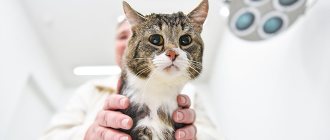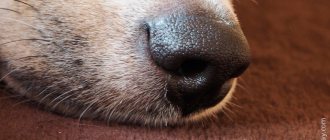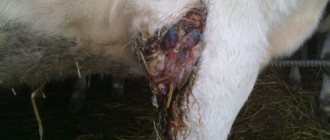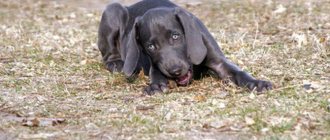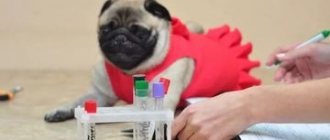What is mastopathy in dogs
Mastopathy is a series of diseases in which the growth of breast tissue occurs. At the initial stage of development, such growth is not harmful or dangerous, but can cause inconvenience.
Mastopathy develops:
- inside the mammary glands;
- over the milk ducts of the nipples;
- over the nipples themselves.
The disease can affect only one nipple or several at the same time. What tumors look like varies. For example, they may be grayish or bluish in color, and sometimes they are just slightly swollen nipples and a slight bulge around them without a change in color. Sizes and shapes are also very different
Diagnostics
Diagnosis of tumor pathology in the dog’s mammary gland is carried out as follows:
- Feeling the mammary glands of a female, who is first in a standing position, and then in a lying position. This is necessary to exclude the diagnosis of a hernia and detect the affected lobes.
- Determination of pain, consistency, size and mobility of the affected areas.
- Examination of all lymph nodes to which there is access in order to exclude the spread of metastases.
- Carrying out tissue biopsy and morphological examination of material susceptible to pathology.
- X-ray examination of the abdominal and thoracic cavities to exclude the presence of metastases in the internal organs.
In the initial stages of mastopathy there is rarely pain, even in cases where the diameter of the tumor reaches 10 cm and several lobes are involved. The formation has a clearly defined shape without inflammatory processes affecting surrounding tissues. The level of mobility and consistency density depend on the size of the formation.
Involvement in the pathological process does not occur immediately. With the development of mastopathy, an increase in lymph nodes and loss of their mobility is observed. However, no pain is observed. Also, to diagnose mastopathy, biochemical studies are carried out for the following hormones:
- follicle-stimulating;
- luteotropic;
- progesterone;
- estradiol
An increase in their level may be a sign of the development of mastopathy in a dog. However, it should be clarified that these same signs are not characteristic of developing pathologies of the reproductive organs. Thus, making a diagnosis based solely on biochemical results will not be correct. To be completely sure, a biopsy is necessary.
Types of mastopathy
There are about 30 forms of this disease in people. There are only 2 forms of mastopathy in dogs:
- diffuse;
- fibrocystic.
They are both dangerous because they can develop from a benign to a malignant tumor if left untreated for a long time. Degeneration occurs due to changes in cell structure under the influence of an activating factor.
Fibrocystic
The term "fibrosis" refers to connective tissue that has grown, that is, has become fibrous. Its structure is similar to scars, which feel like hard formations under the skin. A cyst is an elastic sac filled with fluid inside. It can move from side to side and will be much softer to the touch. If fluid accumulates, it stretches surrounding tissue. It is not dangerous, but may cause pain.
Important! Fibrocystic changes in the breast are not cancerous. And they don't increase your pet's chance of getting cancer. But they do not cancel the fact that the detected tumor may turn out to be malignant.
Diffuse
Diffusion is the process of spreading or penetrating some cells inside others. Accordingly, diffuse mastopathy is the initial stage of the disease, which over time develops into fibrous. In this case, small nodules will be felt under the skin.
Symptoms
Symptoms of mastopathy in dogs can vary. However, the disease can be confidently identified by the following symptoms:
- significant enlargement of the mammary glands;
- granularity or veininess of the glands, detected upon palpation;
- presence of ichor discharge from the nipples;
- painful sensations in the area of the mammary gland, accompanied by the dog’s attempts to lick it;
- rapid weight loss;
- complete refusal to eat and drink;
- manifestation of apathy and weakness;
- hair loss in areas where tumors form and increased skin temperature;
- the occurrence of ulcerative lesions.
The main sign that the disease has reached the malignant stage is a cough. The occurrence of this symptom indicates metastatic damage to internal organs.
Why does mastopathy appear in dogs?
The exact causes of the development of mammary tumors in dogs are not fully understood. But their appearance is definitely influenced by hormones. For example, progesterone stimulates growth factors and this causes cells to multiply.
In addition, among the probable causes of mastopathy:
- mastitis of the mammary gland due to stagnation of milk;
- chest injury;
- fungal infection;
- false pregnancy.
The incidence of tumors depends on whether the dog is intact or has had an ovariohysterectomy (removal of the ovaries). Bitches spayed before their first heat have a 0.5% chance of developing tumors. However, if the procedure is carried out after the first or second heat, then it increases to 8% and 26%, respectively.
It is believed that age is also an influencing factor. It is known that mastopathy is more often diagnosed in dogs older than 6 years. The development and modification of tumors follow the hormonal cycle of the dog's reproductive fertility - they either increase or decrease.
The likelihood of a tumor degenerating into a malignant one increases in animals older than 8 years. But such a development of events is not necessary. For rebirth some factors must come into play.
Important! Dogs of any gender can develop harmless, non-cancerous or benign cysts on the mammary glands. This is not a problem, but it is important that they are examined by a veterinary oncologist.
Which dogs are at risk?
The most common dogs that suffer from mammary tumors are:
- poodles;
- dachshunds;
- spaniels.
In canines, obesity at a young age is also a risk factor. Bitches who are given medications to reduce libido are more likely to develop mastopathy than those who are not given such medications. Therefore, researchers note that hormones are one of the main causes of mastopathy.
If the disease can occur in a dog of any breed, then when it comes to the degeneration of a tumor into a malignant form, several breeds are indicated that are predisposed to such a change. Among them:
- chihuahua;
- poodles;
- dachshunds;
- Yorkshire Terriers;
- cocker spaniels;
- British spaniels;
- English setters;
- boxers;
- Doberman pinschers.
Research in this area of veterinary medicine continues. But today scientists are not ready to say exactly which genes cause the mutation in dogs.
Mammary cancer in dogs: Prevention
According to research by foreign veterinarians, the risk of mammary gland tumors in dogs castrated before their first heat is minimal. If sterilization is carried out after three estrous cycles, then this has almost no effect on the appearance of oncology. These data were published back in 1969. And today this information has only been confirmed.
It is also not recommended to use drugs to eliminate unwanted estrus and pregnancy.
Don't forget to periodically inspect your dog's belly for lumps.
How do symptoms appear?
Symptoms of fibrocystic mastopathy in dogs:
- swelling of the mammary gland;
- compaction of the tissue around it;
- lumpy;
- pain;
- asymmetry of the glands;
- redness of the skin around the nipples;
- discharge from the nipple.
Did you know? Before lying down, many dogs roll around in one place. This instinctive action has been ingrained in them since ancient times. In this way, wild dogs drove away snakes and insects from their sleeping areas.
One gland may have more nodes than others. Also, the animal sometimes experiences increased body temperature, lethargy, increased thirst, and loss of appetite. If we are talking about a nursing bitch, then she may not allow the puppy to suckle on the sore breast.
Symptoms
The disease can be identified by the following symptoms:
- The mammary glands may become significantly enlarged;
- When palpating the glands, you may notice that they are granular or veiny;
- Discharge of ichor from the nipple;
- Pain in the area of the mammary glands and attempts to lick them;
- Rapid weight loss;
- Refusal of food and water;
- Weakness and apathy;
- In the place where the tumor grows, hair will begin to fall out and the skin will be hot;
- The appearance of ulcers.
A cough indicates that the disease has entered the malignant stage. It is this symptom that indicates metastatic damage to other internal organs.
How is the diagnosis carried out?
A general physical examination of the dog is needed to determine:
- location, size and character of all mammary glands;
- enlargement of local lymph nodes.
A typical procedure for diagnosing mastopathy is fine needle aspiration. It involves sucking a sample of cells from the tumor with a needle and examining them under a microscope. Considering that the tumor under study can be either benign or malignant, it is very important to correctly diagnose it. Your veterinarian may recommend a biopsy (surgical removal of part of the tumor) or complete removal.
A complete and chemical blood test and urine test are performed to assess the health of the animal's internal organs before surgery. A chest X-ray and ultrasound of the abdominal cavity are performed if there is a suspicion that the tumor has become cancerous. Remember that microscopic cells (metastases) are difficult to detect. Therefore, the sooner treatment begins, the lower the risk for your pet.
Important! A dog with multiple mammary tumors may be diagnosed with both benign and malignant tumors at the same time. Therefore, the doctor must evaluate all of them under a microscope.
For what reasons can a pet get sick?
This pathology in dogs can be caused by various factors. Among them:
- Mastitis caused by a bitch giving birth to dead puppies.
- False pregnancy in an animal.
- Breast injuries.
- Damage to tissues by pathogenic microorganisms, fungi (observed when sanitary requirements for living conditions for pets are violated).
Most often, an increased level of the hormone progesterone leads to the appearance of polypheatous mastopathy in bitches. If the animal does not participate in mating, does not give birth and does not feed puppies, it can lead to the development of not only a benign, but also a malignant tumor.
For this reason, those dog breeders who do not intend to allow their pet to be bred are recommended to sterilize it - this significantly reduces the risk of mastopathy.
Treatment of mastopathy in dogs
Some benign lesions may never change and remain small and harmless. They are easier to detect and treat when they have just begun to develop. But there is no generally accepted standard of treatment for mastopathy in dogs. Therefore, they begin by eliminating the cause that could cause the disease:
- prescribe antibiotics when a bacterial infection is detected;
- Hormones are prescribed if a hormonal imbalance is detected.
Surgery is considered the most correct and effective method of treating tumors. If it is a cyst, the doctor can puncture and drain it. This will reduce the pain. But cystic fluid can return, although sometimes cysts go away on their own.
With the help of drugs
If the cause is a false pregnancy or hormonal imbalance due to the loss of puppies, then drug therapy will be offered. It is carried out at home. If the cause is bacterial infection through nipple cracks, then antibiotics will be prescribed. To relieve the inflammatory process as a result of injury, anti-inflammatory drugs Travmatin and Mastometrin are prescribed. They are administered subcutaneously once a day for 3–5 days.
Carrying out the operation
Surgery is the most correct way of treatment. Sometimes muscle tissue may be removed, as well as some skin and fat. This is necessary to reduce the risk of local tumor recurrence. If there are more than 2-3 tumors on one mammary gland, your veterinarian may recommend surgery to remove the entire gland.
Important! For older dogs, surgery is contraindicated; it can be done if there are no liver or heart diseases.
What to do at home
After surgery, the dog is placed in an Elizabethan collar for 10–14 days to prevent licking of the incision. At home, the owner must monitor the condition of the seam. If swelling does not subside or redness appears, it is important to consult a veterinarian. Allow your pet to rest for 48 hours after surgery. A bandage may also be required.
Your doctor will also recommend small lifestyle changes to help ease your symptoms:
- remove salt from the diet to reduce swelling;
- will prescribe a diuretic to reduce the amount of fluid in the tissues;
- Avoid letting your dog touch surfaces that are too cold with its chest or overheat;
- It is important to avoid excessive physical activity during treatment.
Compresses and massage
Massage therapy makes sense if we are talking not about mastopathy, but about mastitis. This disease refers to inflammation of the mammary gland. But before massaging, you need to make sure that the animal does not develop sepsis. To do this, the dog must be examined by a veterinarian. She will be assigned:
- antibiotics that will relieve inflammation and destroy detected bacteria;
- warm water compresses for 10 minutes several times a day;
- pumping.
In acute cases, intravenous drips will be prescribed or surgical removal of the mammary gland will be performed, if necessary. The decision about whether the bitch should continue to feed the puppies or whether they need to be bottle-fed immediately must be made by the veterinarian.
There is no proven data on the effectiveness of massage for mastopathy in dogs. It must be remembered that this disease is characterized by tissue proliferation, and not inflammation or compaction. This makes massage impractical.
Did you know? The dog has an excellent sense of smell. For example, a fox terrier has 147 million odor-sensing cells, a German shepherd has 220 million, while a human has only 5 million.
Folk remedies
There are no effective traditional medicines whose usefulness for mastopathy in animals has been proven. Therefore, it is better for the dog owner to rely on the doctor’s recommendations received after examining the pet and follow them.
Causes
Mastitis is considered the main cause of the disease. Most often, this pathology can be observed in females who gave birth to dead puppies. Another possible cause of mastitis is the contamination of the glands with pathogenic microorganisms or fungi. In the absence of timely treatment, inflammatory processes begin to spread and become the cause of mastopathy. In addition, a false pregnancy can provoke this disease. It is quite rare to see the development of mastopathy in a nursing female.
Possible complications
Suture dehiscence occurs in the mammary glands near the hind legs or after large areas of tissue have been removed. This is the most common complication after surgery. Recurrence of the tumor or the appearance of metastases for malignant neoplasms is also possible.
If the breast tumor is malignant, the surgical site and nearby lymph nodes should be checked for local recurrence every 3 months for the first 12 months after surgery and every 6 months thereafter. Abdominal ultrasound and chest x-ray are recommended every 3 to 6 months to evaluate for signs of metastasis.
Stages of mastopathy
Tumors often affect the 3rd-5th lobes of the mammary gland. The reason for this is their structure, namely the large volume of glandular tissue in these parts of the organs. Mostly the disease begins with the development of single small formations. If other lobes are involved in the tumor, then this indicates the occurrence of a serious pathological process, which indicates that the tumors have begun to spread. The consequence may be damage by metastases to the lymph nodes and internal organs.
The early stage of development of mastopathy in dogs is characterized by the presence of small single mobile formations in which there is no pronounced pain. The severity of the pathological process depends on the size of the tumors and their spread.
The cancerous process is characterized by a painful reaction, severe local hyperthermia and redness. The tumor does not have clearly defined boundaries, since the growth of malignant cells spreads to the surrounding nearby tissues. In this case, it is not possible to identify foci of inflammation. This is a consequence of the fact that the formation of a barrier between healthy and diseased tissues does not occur. A feature of malignant tumors is that they are immobile, as they grow together with muscles and skin.
The late stage of mastopathy development differs from others in the large size of the tumor. Its diameter can reach more than 20 cm, and its weight can reach several kilograms. At this stage, the site of tumor development is covered with skin defects in the form of non-healing ulcers and ulcers. There is a significant enlargement of the lymph nodes and when pressure is applied the dog feels severe pain.
Treatment at home
Let us immediately warn you that treatment at home is more or less effective only in the initial stages. In advanced cases, only surgical intervention in a clinic will help (and even then without any special guarantees).
Homeopathic remedies
Homeopathic remedies sometimes show surprisingly good results. In particular, the following medications are used:
- Mastodinon.
- Masto-Gran.
- Phytoelite Cytostat.
- Trauma gel.
Medications for the treatment of mastopathy
In veterinary practice, the following drugs are used to treat mastopathy:
- Duphaston. A hormonal agent, the use of which allows you to increase the content of progesterone in the body. In some cases, its analogue, utrozhestan, can be used. Both medications are medical, and therefore a veterinarian must prescribe them and calculate the dosage. The medications are absolutely safe for long-term use.
- Mastomethrin is also a specific remedy. Allows you to cope with inflammatory processes.
- Anti-inflammatory corticosteroids may be used with extreme caution and only after screening for cancer.
Diagnosis of mastopathy
As a rule, the diagnosis of mastopathy is performed according to the generally accepted, standard scenario:
- Careful palpation of the affected lobes of the mammary glands is carried out. During this process, an experienced veterinarian differentiates, eliminating other possible causes (edema, hernia, parasites).
- It is very important to accurately identify the boundaries, size, pain and location of tumors.
- Lymph nodes must be examined and biopsied. This is done to detect signs of cancer, because... In oncology, lymph nodes are affected in almost 100% of cases.
- Tissue samples from the affected areas of the mammary glands are taken.
- X-rays and ultrasound examinations of the chest and abdomen are performed.
- In more advanced clinics, they do a biochemical blood test to find/not find specific cancer markers.
Surgery to remove the tumor
The only reliable method of treatment (especially at the third stage) can only be considered an operation to remove the tumor in a clinical setting. As practice shows, it is almost useless to fight advanced mastopathy with the help of medications.
In this case, the operation is quite difficult, since the entire mammary gland is cut out from the affected side. If mastopathy has affected both halves, the mammary glands are completely excised. After the procedure, the dog must be observed by a veterinarian for at least six months.
